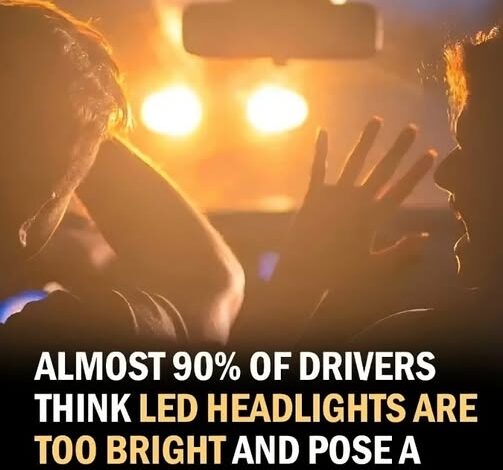The Majority of Drivers Think LED Headlights Are Too Bright

In recent years, LED headlights have transformed the automotive industry, offering better visibility and energy efficiency. However, what was once hailed as a technological advancement is now facing criticism from drivers worldwide. Many consider these headlights excessively bright, raising safety concerns and creating discomfort during nighttime driving. This article explores the root cause of the issue, its global impact, and possible solutions to restore balance between visibility and comfort.
Why Are Drivers Frustrated? LED headlights have undeniably improved visibility for drivers, but their intense beams come with unintended consequences. A survey by the RAC in the UK found that 89% of drivers believe LED headlights are too bright, and 85% feel the glare has worsened over time.
Similar concerns have been voiced in the U.S. Mechanical engineer Victor Morgan conducted independent tests showing that the glare from LED headlights often exceeds regulatory limits. This growing frustration has turned what was once a celebrated innovation into a safety hazard.
The Pros and Cons of LED Technology When LED headlights were first introduced, they were praised for several key benefits:
- Enhanced Visibility: Their focused beams allow drivers to see further at night.
- Energy Efficiency: LEDs consume less power compared to traditional halogen bulbs.
- Longevity: These lights last significantly longer than conventional headlights.
However, these benefits come with a downside. The intense brightness of LEDs can temporarily blind oncoming drivers, especially on poorly lit roads. This has led to growing calls for changes to improve the balance between visibility and comfort.
Misaligned Headlights: The Silent Culprit One of the main contributors to the glare issue is misaligned headlights. Mark Rea from the Light and Health Research Center explains that improperly adjusted headlights, particularly on SUVs and trucks, can significantly increase glare for drivers of lower vehicles.
“It’s not every car,” Rea notes, “but about 20% of vehicles have glaring issues.” Misalignment not only causes discomfort but can also lead to accidents due to reduced visibility and slower reaction times.
The Real-World Impact of LED Brightness Drivers have reported several challenges caused by excessively bright headlights:
- Slower Reaction Times: Many drivers reduce their speed on poorly lit roads to cope with the glare, which can increase travel times and accident risks.
- Increased Reliance on Night Driving Glasses: The discomfort has led some to purchase specialized glasses that reduce glare. While helpful, these glasses only mask the issue rather than solving it.
Calls for Regulatory Intervention Experts and advocacy groups are urging regulatory bodies, such as the National Highway Traffic Safety Administration (NHTSA) in the U.S., to revisit headlight brightness guidelines. Current regulations are criticized for not addressing real-world driving conditions.
Mark Baker, president of the Soft Lights Foundation, summarizes the issue: “Everyone is mystified by why they are being blinded.” This concern is shared globally, with 64% of UK drivers believing LED headlights increase accident risks due to their brightness.
Potential Solutions for Safer Roads Several solutions can help reduce glare:
- Adaptive Lighting Technologies: Advanced systems can automatically adjust headlight brightness and direction based on road conditions. For example, they can dim when detecting oncoming vehicles. However, these technologies are still not widely available due to cost and limited adoption.
- Regular Headlight Alignment: Vehicle owners can reduce glare by ensuring their headlights are properly aligned. Regular maintenance can make a significant difference.
- Stricter Manufacturing Standards: Automakers could implement stricter controls on beam angles and brightness levels, ensuring headlights are safe and comfortable for all drivers.
Driver Responsibility in Reducing Glare While long-term solutions are being developed, drivers can take immediate steps to reduce glare:
- Check Headlight Alignment: Misaligned headlights, especially on taller vehicles, can exacerbate glare.
- Use Low Beams When Appropriate: High beams can worsen the issue for other drivers, so use them only when necessary.
- Avoid Aftermarket LED Bulbs: Installing overly bright or poorly designed bulbs can increase glare.
Conclusion: Striking a Balance LED headlights were designed to improve safety, but their intense brightness has created new challenges. By addressing misalignment issues, implementing adaptive technologies, and revising regulatory standards, it is possible to find a solution that prioritizes both visibility and driver comfort.
Ultimately, all stakeholders—manufacturers, regulators, and drivers—must work together to create glare-free roads. Bright lights should enhance our journeys, not hinder them.